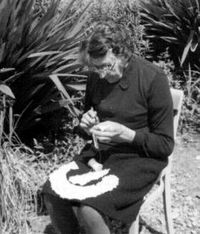Clones Lace: Difference between revisions
No edit summary |
No edit summary |
||
| Line 1: | Line 1: | ||
In the 1901 census of Ireland form A, many young women in the Clones area entered their occupation as “lace maker” “crocheter”, “crochet-maker”, “lace-joiner” or “lace buyer”. The townland of [[Aghadrumsee]] had five women employed in this way, [[Killyfole]] had five, [[Loughgare]] had six and [[Drumaa]] and [[Dernawilt]] each had seven . Nearly every townland around Killyfole Lough had at least one woman who gave her occupation as part of the Clones lace-making community. | In the 1901 census of Ireland form A, many young women in the Clones area entered their occupation as “lace maker” “crocheter”, “crochet-maker”, “lace-joiner” or “lace buyer”. The townland of [[Aghadrumsee]] had five women employed in this way, [[Killyfole]] had five, [[Loughgare]] had six and [[Drumaa]] and [[Dernawilt]] each had seven . Nearly every townland around Killyfole Lough had at least one woman who gave her occupation as part of the Clones lace-making community. | ||
[[Image:SarahJohnstonLammy.jpg|Mrs Sarah Johnston, Lammy makes a neck collar| | [[Image:SarahJohnstonLammy.jpg|200px|Mrs Sarah Johnston, Lammy makes a neck collar|]] | ||
The person responsible for introducing this industry to the area was Mrs Cassandra Hand, who was the wife of the then Rector of Clones Parish Church. Mrs Hand employed an expert teacher, arranged classes and organised the sale of the finished lace. The craft was introduced in post famine years as a way of making money and it did not involve much expenditure on the part of the craftswoman. The only materials needed were a crochet hook and some thread. The equipment took up little space and the women could work anywhere in the home. | The person responsible for introducing this industry to the area was Mrs Cassandra Hand, who was the wife of the then Rector of Clones Parish Church. Mrs Hand employed an expert teacher, arranged classes and organised the sale of the finished lace. The craft was introduced in post famine years as a way of making money and it did not involve much expenditure on the part of the craftswoman. The only materials needed were a crochet hook and some thread. The equipment took up little space and the women could work anywhere in the home. | ||
Revision as of 21:31, 6 August 2012
In the 1901 census of Ireland form A, many young women in the Clones area entered their occupation as “lace maker” “crocheter”, “crochet-maker”, “lace-joiner” or “lace buyer”. The townland of Aghadrumsee had five women employed in this way, Killyfole had five, Loughgare had six and Drumaa and Dernawilt each had seven . Nearly every townland around Killyfole Lough had at least one woman who gave her occupation as part of the Clones lace-making community.
The person responsible for introducing this industry to the area was Mrs Cassandra Hand, who was the wife of the then Rector of Clones Parish Church. Mrs Hand employed an expert teacher, arranged classes and organised the sale of the finished lace. The craft was introduced in post famine years as a way of making money and it did not involve much expenditure on the part of the craftswoman. The only materials needed were a crochet hook and some thread. The equipment took up little space and the women could work anywhere in the home.
